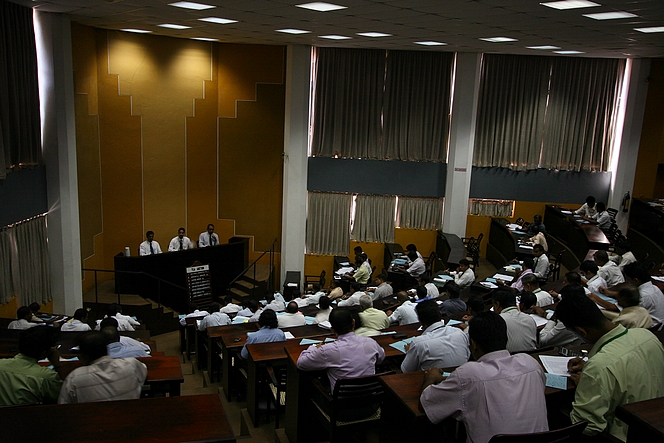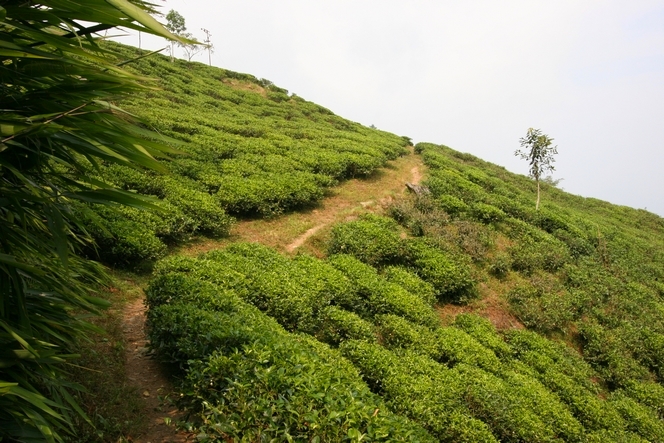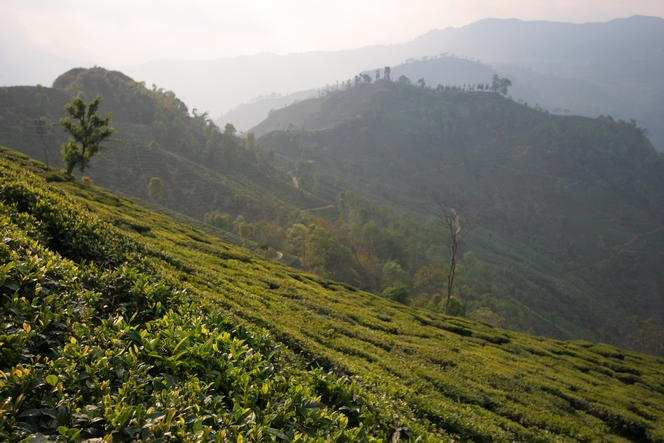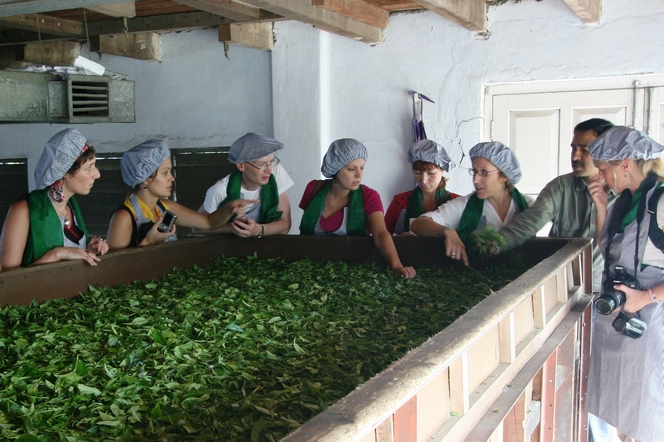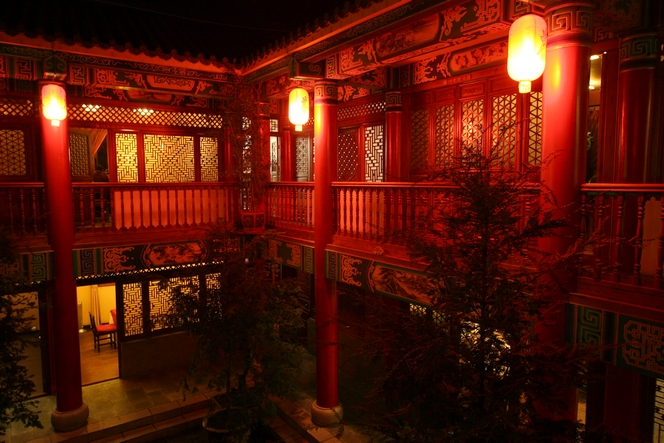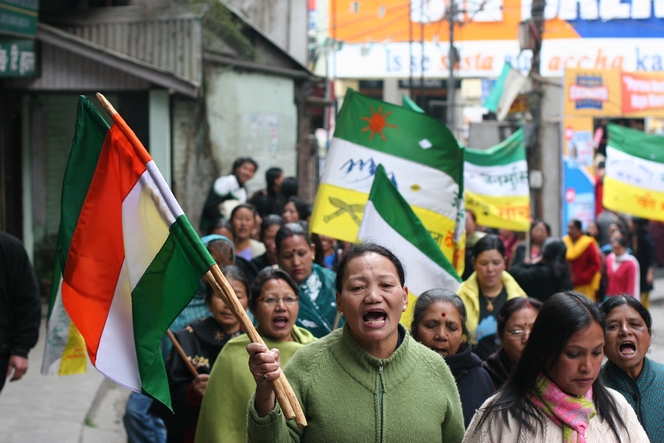The Maison & Objet fair in Paris has just ended. Twice a year, trade visitors from all over the world come to this great event which, as its name indicates, focuses on homeware and objects. The tableware sector is an important element of this fair, which is why Palais des Thés was there with a stand, to present its latest collections. An illuminated river of teapots descending from the ceiling appears to amuse this laughing tea picker, projected and lit up on the outskirts of Paris.
News
In Colombo, weekly tea auctions are held
I am writing this in Colombo, in the room where the weekly tea auctions are held. In fact there are many auction rooms like the one I’m sitting in now, where different grades are sold.
The three people you see on the platform are brokers. In the days preceding the auction they will have received hundreds of samples from the tea plantations. They print a catalogue listing all the lots of tea available, which they send to the exporters, and today they are selling the teas.
The men sitting in this room – strangely there are no women – are exporters. They are officially recognised as such, and are almost the only people with the right to export tea from Sri Lanka.
What amuses me about this photo is that everyone seems so calm, whereas in reality the place is buzzing with activity. The man in the centre of the platform is announcing the lots to be sold and is speaking at an incredible rate. A few seconds later he brings the hammer down and moves on to the next sale. He spots a man raising an eyebrow, which means he is bidding higher, or another lifting a finger, and when nobody else moves, it means the deal is done.
Darjeeling : blocked situation
The news from Darjeeling is not improving. The Gorkhaland separatists have stepped up their campaign and have basically blocked the movement of the trucks transporting tea. Every day we receive samples, and we can buy the teas, but if they can’t be taken to Kolkata airport, what’s the point? This could last a few days, or several weeks. So the struggle with the government goes on, but where will it lead?
“Where will it lead?” That’s exactly the question I ask myself as I walk the little paths of Darjeeling, like here in Badamtam. I walk without really knowing where I’m going, just following my nose. It’s wonderful! And if I get lost, what does it matter? After all, it’s only me.
Darjeeling : tea trade is threatened
The situation in Darjeeling has improved considerably. The road blocks have been lifted, the shops have reopened and life is getting back to normal. But the tea trade is still affected, as the party campaigning for independence is threatening to prevent the movement of trucks carrying the tea in a few weeks’ time, in order to demonstrate its political clout and bring negotiations to a conclusion.
However, this does not stop me from enjoying a quiet moment tasting teas, as I am about to do here at the Teesta Valley Tea Estate factory.
In Darjeeling, I have had to change my plans
Because of the heightened unrest in Darjeeling this year, I have had to alter my plans. The movement in favour of the region’s independence will decide today whether or not to block all the roads and shut down the shops again. So instead of visiting the Balasun plantation in the Kurseong region, I have decided to take a detour east. My friend Abhishek Dev, the grower at the Teesta Valley Tea Estate, came to collect me a short while ago from Bagdogra airport, and took me to his bungalow. Teesta Valley Tea Estate is in the extreme east of Darjeeling and from here, I can decide whether to go to Darjeeling city or not, depending on the turn of events tomorrow. At least, thanks to Abhishek, I have the latest news from Darjeeling and on the forthcoming harvest. And this evening, I can also meet the growers from Gielle, Runglee Rungliot and maybe Namring. These four tea plantations, situated at quite a distance from Darjeeling city but, of course, within the prestigious “appellation”, are some of the most beautiful in the region. In this photo you can see the view I have from here, in the late afternoon, walking towards the Gielle Tea Estate.
Le Palais des Thés team in Tomsong
This morning I left for Kolkata. From there I will travel to Darjeeling, probably on Tuesday. The spring harvest will begin soon, and it is time to visit a few plantations, find out more about the crop, and “test the temperature” of the region in more ways than one. Tea plants go to sleep in the winter, because of the cold, and wake up again when the air warms up. Inversely, the people get fired up during the winter months over the issue of independence, and cool down in the spring when the tea and tourist trades pick up again.
There is an important stage in tea processing that I am sorry not to be able to share with you: the “withering”. This involves blowing air – preferably cold – over the leaves, which give off an incredible fragrance like white flowers, lily and jasmine. In this photo taken in Tomsong in October 2010, during a trip with the team, everyone is cupping leaves in their hands and inhaling the wonderful aroma.
If you would like to see some other highlights from our trip, click on this link (in French):
http://www.palaisdesthes.com/fr/le-the/palais-des-thes-darjeeling.htm
Tea houses are flourishing in China
There were many tea houses in China until Mao shut them down. No dens of vice, they represented entertainment and debate. People went to tea houses to enjoy a cup of tea and join in a discussion, or for a poetry reading, or simply to sit and listen to the chirping of the caged crickets.
Today, tea houses are back in fashion. They are flourishing all over China, and it is interesting to see the very young clientele that regularly frequents them. These customers clearly enjoy a certain standard of living, because tea is not always cheap in the tea houses, especially those located in areas popular with tourists, like this one in the centre of Kunming, by the delightful Green Lake.
In Shizuoka, a festival is dedicated to green tea
As you read this, I will be arriving in the Land of the Rising Sun. I am here because every three years, a celebration of green tea is held in the Shizuoka region: the O’Cha Festival. It is an opportunity to meet many farmers who grow tea in the surrounding mountains and who leave their tea plants to come and meet other growers, customers and journalists. At the festival, you can try many teas, or watch a matcha tea being made, or a temomi cha, the tea that is entirely processed by hand.
Drinking green tea, whether a superior quality or an everyday brew, is part of Japanese culture. The Japanese serve green tea throughout the day and even drink it while walking in the street, getting it from the numerous vending machines you see everywhere in the country. The Japanese ceremony of Cha no Yu is deeply rooted in tradition, going back more than 500 years, like the Ikebana art of flower arranging, for example.
At the O’Cha Festival, you can taste some very special teas. Several competitions are held during the fair to select the best green teas of the year.
The farmers are immensely proud of the recognition this brings their tea. Here is one family in the middle of harvesting a sencha. Their plot is not big, but their tea is worth its weight in gold.
In Darjeeling, a separate state is subject of debate
There has been political tension in Darjeeling for some 30 years. While everyone agrees on remaining within the Indian Union, a large proportion of the population would like some independence, with their own Indian state, instead of being part of West Bengal as the region is today. Being a separate state, like neighbouring Sikkim, might result in better infrastructures, with direct funding from the capital Delhi instead of having to wait for aid that never comes from Kolkata. Most people in Darjeeling are Indians of Nepalese origin who would prefer to be able to make their own decisions on matters that concern them. Some have already given the future state a name which you see scrawled along the roadsides, and which is being chanted by these protesters marching in Darjeeling: “We want Gorkhaland!” You can see they are waving two different flags: the flag of the future Gorkhaland, and the flag of India, to show that they want the new state to be firmly embedded within the Indian Union.
This Sunday at 2.45pm on France 5: “Tea for all”!
There are not many documentaries on tea, so when one comes up on television we shouldn’t miss it. As part of its Global Drinks series, France 5 is showing a documentary called “Thé pour tous” (Tea for all), this Sunday at 2.45pm. The report lasts 52 minutes, which is quite exceptional. The director Stefano Tealdi travelled through various countries including Japan, Taiwan, the UK and India, and also stopped in Paris. We met a year ago and I agreed to him accompanying me into the tea mountains. So in February, we met in Kolkata. We then took the Darjeeling route in the company of Sandro DeFrino, his camera man, and Angelo Galeano, his sound recordist.
It is not easy to travel with a TV crew in places you love, on the other side of the world. It’s a bit like being with a bull in a china shop. But with Stefano, Angelo and Sandro it was real pleasure; all of them treated everyone we met with great respect, and they showed a deep understanding of the nuances of local identities. It’s a rare thing. I was very pleased to have met them. I think we started to develop a friendship and I’m looking forward to seeing their film.
In this photo, taken in Kolkata, Stefano Tealdi, with his back to the camera, is talking to Krishan Katyal, director of the tea auctioneers J Thomas & Co. Krisham is one of the leading experts in India, and I’m sure I’ll be telling you more about him another time.
Ps: for the people who, like me, do not have the television, you can clic here http://documentaires.france5.fr/documentaires/global-drinks/pour-tous to view the programme until October 24th


